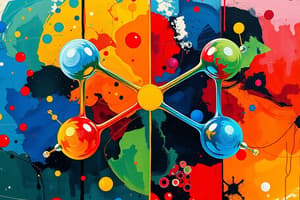Podcast
Questions and Answers
Which type of isomers differ in the way atoms are connected to each other?
Which type of isomers differ in the way atoms are connected to each other?
- Constitutional isomers (correct)
- Geometric isomers
- Stereoisomers
- Enantiomers
What characteristic do stereoisomers share?
What characteristic do stereoisomers share?
- Different physical properties
- Different functional groups
- Identical IUPAC names (correct)
- Different IUPAC names
What defines a chiral molecule?
What defines a chiral molecule?
- It is not superimposable on its mirror image. (correct)
- It has identical structural formulas.
- It can be superimposed on its mirror image.
- It has multiple functional groups.
Which of the following statements is true about achiral molecules?
Which of the following statements is true about achiral molecules?
The test for chirality involves what key steps?
The test for chirality involves what key steps?
What characterizes enantiomers?
What characterizes enantiomers?
Which of the following statements about stereogenic centers is true?
Which of the following statements about stereogenic centers is true?
What is a necessary condition for a molecule to be considered achiral?
What is a necessary condition for a molecule to be considered achiral?
Which type of carbon hybridization creates a stereogenic center?
Which type of carbon hybridization creates a stereogenic center?
In how many stereoisomers can a molecule with two stereogenic centers exist?
In how many stereoisomers can a molecule with two stereogenic centers exist?
How can enantiomers be drawn?
How can enantiomers be drawn?
Which of the following is a feature of chiral molecules?
Which of the following is a feature of chiral molecules?
Why do achiral molecules typically contain a plane of symmetry?
Why do achiral molecules typically contain a plane of symmetry?
What determines whether a carbon in a cyclic compound can be a stereogenic center?
What determines whether a carbon in a cyclic compound can be a stereogenic center?
Which statement is true regarding enantiomers of thalidomide?
Which statement is true regarding enantiomers of thalidomide?
In labeling stereogenic centers, what is the first rule for assigning priorities?
In labeling stereogenic centers, what is the first rule for assigning priorities?
What is the significance of assigning the R or S designation to a stereogenic center?
What is the significance of assigning the R or S designation to a stereogenic center?
What is a requirement for a cyclic compound to have a stereogenic center?
What is a requirement for a cyclic compound to have a stereogenic center?
What should be considered when assigning priorities if two atoms are identical?
What should be considered when assigning priorities if two atoms are identical?
How is the priority assigned when dealing with multiple bonds at a stereogenic center?
How is the priority assigned when dealing with multiple bonds at a stereogenic center?
What is a characteristic of 3-methylcyclohexene?
What is a characteristic of 3-methylcyclohexene?
What is the first step in assigning R or S configuration to a stereogenic center?
What is the first step in assigning R or S configuration to a stereogenic center?
How do you visualize the configuration after assigning priorities to the groups?
How do you visualize the configuration after assigning priorities to the groups?
When tracing a circle during the assignment of R or S, which groups are involved?
When tracing a circle during the assignment of R or S, which groups are involved?
What is the maximum number of stereoisomers possible for a compound with two stereogenic centers?
What is the maximum number of stereoisomers possible for a compound with two stereogenic centers?
What is the relationship between the two stereoisomers formed from one stereogenic center?
What is the relationship between the two stereoisomers formed from one stereogenic center?
In finding all possible stereoisomers for a compound with two stereogenic centers, what is the first step?
In finding all possible stereoisomers for a compound with two stereogenic centers, what is the first step?
What is the purpose of labeling stereogenic centers as R or S?
What is the purpose of labeling stereogenic centers as R or S?
Which of the following statements about stereoisomers is true?
Which of the following statements about stereoisomers is true?
Which statement accurately describes the cis isomer of 1,3-dibromocyclopentane?
Which statement accurately describes the cis isomer of 1,3-dibromocyclopentane?
What distinguishes the trans isomer of 1,3-dibromocyclopentane from its mirror image?
What distinguishes the trans isomer of 1,3-dibromocyclopentane from its mirror image?
What happens to plane-polarized light passing through an optically active compound?
What happens to plane-polarized light passing through an optically active compound?
Which instrument measures the optical activity of a compound?
Which instrument measures the optical activity of a compound?
What is true about a compound that is classified as achiral?
What is true about a compound that is classified as achiral?
In stereochemistry, what are the only two kinds of stereoisomers?
In stereochemistry, what are the only two kinds of stereoisomers?
What occurs when light exits from an achiral compound through a polarimeter?
What occurs when light exits from an achiral compound through a polarimeter?
How do the chemical and physical properties of enantiomers compare?
How do the chemical and physical properties of enantiomers compare?
What is true about diastereomers?
What is true about diastereomers?
What defines a meso compound?
What defines a meso compound?
How are the R and S designations assigned when there are multiple stereogenic centers?
How are the R and S designations assigned when there are multiple stereogenic centers?
Which of the following statements is correct regarding 2,3-dibromobutane?
Which of the following statements is correct regarding 2,3-dibromobutane?
What occurs when you switch two groups on one stereogenic center of an enantiomer?
What occurs when you switch two groups on one stereogenic center of an enantiomer?
What is a characteristic of enantiomers?
What is a characteristic of enantiomers?
Which description best fits diastereomers in terms of physical properties?
Which description best fits diastereomers in terms of physical properties?
Which statement about stereogenic centers is accurate?
Which statement about stereogenic centers is accurate?
Flashcards
Constitutional Isomers
Constitutional Isomers
Different compounds with the same molecular formula but different atom connectivity.
Stereoisomers
Stereoisomers
Different compounds with the same molecular formula and atom connectivity, but different spatial arrangement of atoms.
Chiral Molecule
Chiral Molecule
A molecule that is not superimposable on its mirror image.
Achiral Molecule
Achiral Molecule
Signup and view all the flashcards
Configuration
Configuration
Signup and view all the flashcards
Enantiomers
Enantiomers
Signup and view all the flashcards
Tetrahedral Stereogenic Center
Tetrahedral Stereogenic Center
Signup and view all the flashcards
Stereogenic Center
Stereogenic Center
Signup and view all the flashcards
One Stereogenic Center
One Stereogenic Center
Signup and view all the flashcards
Two or More Stereogenic Centers
Two or More Stereogenic Centers
Signup and view all the flashcards
Drawing Enantiomers
Drawing Enantiomers
Signup and view all the flashcards
Stereogenic Center in a Cyclic Compound
Stereogenic Center in a Cyclic Compound
Signup and view all the flashcards
Identifying Stereogenic Centers in Rings
Identifying Stereogenic Centers in Rings
Signup and view all the flashcards
Thalidomide: A Chiral Drug
Thalidomide: A Chiral Drug
Signup and view all the flashcards
Why Assign R or S Configurations?
Why Assign R or S Configurations?
Signup and view all the flashcards
Priority Rule 1: Atomic Number
Priority Rule 1: Atomic Number
Signup and view all the flashcards
Priority Rule 2: Same Atom, Different Substituents
Priority Rule 2: Same Atom, Different Substituents
Signup and view all the flashcards
Priority Rule 3: Isotope Priority
Priority Rule 3: Isotope Priority
Signup and view all the flashcards
Priority Rule 4: Multiple Bonds
Priority Rule 4: Multiple Bonds
Signup and view all the flashcards
R/S Configuration
R/S Configuration
Signup and view all the flashcards
Priority Rule (1)
Priority Rule (1)
Signup and view all the flashcards
Priority Rule (2)
Priority Rule (2)
Signup and view all the flashcards
Priority Rule (3)
Priority Rule (3)
Signup and view all the flashcards
Diastereomers
Diastereomers
Signup and view all the flashcards
Maximum Stereoisomers
Maximum Stereoisomers
Signup and view all the flashcards
Finding Diastereomers
Finding Diastereomers
Signup and view all the flashcards
Meso Compounds
Meso Compounds
Signup and view all the flashcards
How do you find all possible stereoisomers?
How do you find all possible stereoisomers?
Signup and view all the flashcards
How do you identify enantiomers?
How do you identify enantiomers?
Signup and view all the flashcards
How do you identify diastereomers?
How do you identify diastereomers?
Signup and view all the flashcards
Plane of Symmetry
Plane of Symmetry
Signup and view all the flashcards
1,3-dibromocyclopentane
1,3-dibromocyclopentane
Signup and view all the flashcards
R/S Assignments in Multiple Centers
R/S Assignments in Multiple Centers
Signup and view all the flashcards
Cis Isomers
Cis Isomers
Signup and view all the flashcards
Trans Isomers
Trans Isomers
Signup and view all the flashcards
Optical Activity
Optical Activity
Signup and view all the flashcards
Polarimeter
Polarimeter
Signup and view all the flashcards
Achiral
Achiral
Signup and view all the flashcards
Study Notes
Stereochemistry
- Stereochemistry is the study of the three-dimensional structure of a molecule.
- Isomers are different compounds with the same molecular formula. Only the 3-D arrangement of atoms differ.
- Two main classes of isomers are constitutional (structural) isomers and stereoisomers.
- Constitutional isomers differ in how atoms are connected.
- Stereoisomers differ only in the way atoms are oriented in space.
Thalidomide
- Used as a sedative and anti-nausea drug for pregnant women.
- Sold as a mixture of two enantiomers.
- Enantiomer 1 had the desired therapeutic effect.
- Enantiomer 2 caused catastrophic birth defects in children born to women who took the drug during pregnancy.
Starch and Cellulose
- Recall that stereochemistry is the three-dimensional structure of a molecule.
- Starch is a main carbohydrate found in seeds and roots of plants.
- When consumed, starch is hydrolyzed to glucose.
- Cellulose is nature's most abundant organic material, providing rigidity to tree trunks and plant stems.
- Complete hydrolysis of cellulose also forms glucose. Humans cannot metabolize cellulose to glucose.
Starch and Cellulose (Repeating Units)
- Starch and cellulose are both composed of the same repeating unit.
- The repeating unit is a six-membered ring with an oxygen atom.
- Three OH groups are attached to the ring.
- They differ by the position of the oxygen atom joining the rings together.
- In cellulose, the joining oxygen atom uses equatorial bonds.
- In starch, the joining oxygen atom uses one equatorial and one axial bond.
Isomers, Constitutional and Stereoisomers
- There are two kinds of isomerism - constitutional and stereoisomers.
- Constitutional isomers differ in the way their atoms are connected.
- Stereoisomers differ in the spatial arrangement of their atoms.
Configuration
- Configuration refers to a specific three-dimensional arrangement of atoms.
- Configuration is important to isomers. Isomers have different configurations.
Chiral and Achiral Molecules
- Chiral molecules are not superimposable on their mirror images
- Examples of chiral molecules are your hands. The left hand and right hand are mirror images, but they are not superimposable on each other
- Achiral molecules are superimposable on their mirror images. Examples of achiral molecules include socks.
- To test for chirality, draw a molecule and its mirror image and see if superimpose on each other.
Stereogenic Centers
- Stereogenic centers are atoms in a molecule where the interchange of groups leads to a stereoisomer.
- To identify a stereogenic center, examine each tetrahedral carbon atom (not part of a ring). Count the groups attached to that carbon. If all four groups are different, it is a stereogenic center.
Drawing a Pair of Enantiomers
- To draw a pair of enantiomers, draw the first molecule and use a mirror image to draw a second molecule (the mirror image).
Enantiomers and Stereogenic Centers
- A molecule with one stereogenic center exists as a pair of enantiomers.
- Any molecule with a tetrahedral stereogenic center is chiral and exists as a pair of enantiomers.
Labeling Stereogenic Centers
- Rule 1: Assign priorities to groups bound to stereogenic center in order of decreasing atomic number. Highest atomic number = priority 1
- Rule 2: If two identical atoms are on the stereogenic center, prioritize based on the atomic number of atoms further bonded to identical atoms on the stereogenic center.
- Rule 3: If two isotopes bound to stereogenic center, assign priorities in order of decreasing atomic mass number.
- Rule 4: Multiple bonds treat equivalent numbers of singly bonded atoms.
Diastereomers
- Diastereomers are stereoisomers that are not mirror images.
- With two stereogenic centers, the maximum number of stereoisomers = 4 (some combinations might be superimposable/identical)
- To find the other stereoisomers, change the position of groups on one stereogenic center only and draw its mirror image.
Meso Compounds
- A meso compound has more than one stereogenic center, but the number of stereoisomers is less than the maximum.
- The mirror image of a meso compound is superimposable on the compound itself.
Stereoisomers in Compounds with Two or More Stereogenic Centers
- When a compound has more than one stereogenic center, assign R/S for each center.
Disubstituted Cycloalkanes
- If a cycloalkane has two substituents, the cis isomer is achiral; it is identical to its mirror image.
- The trans isomer is chiral; it is not superimposable on its mirror image.
Optical Activity
- Plane-polarized light passes through a polarimeter.
- Chiral compounds rotate the plane of polarized light.
- Optically active compounds rotate polarized light, while achiral compounds do not.
- Achiral compounds have no effect on the plane of polarized light.
Racemic Mixtures
- A racemic mixture consists of equal amounts of two enantiomers.
- Racemic mixtures are optically inactive; they do not rotate polarized light.
Specific Rotation
- Specific rotation equation = [α] = α / (l x c).
- α: observed rotation
- l: length of sample tube in decimeters
- c: concentration in g/mL
Enantiomeric Excess
- Enantiomeric excess is the percentage of one enantiomer - percentage of the other enantiomer .
- Enantiomeric excess tells us how much of one enantiomer is in excess compared to the other.
Physical Properties of Diastereomers
- Diastereomers have different physical properties compared to enantiomers.
- Thus, diastereomers can be separated from each other using common separation techniques like distillation.
Chemical Properties of Enantiomers
- Enantiomers have identical chemical properties except of their reaction with chiral nonracemic reagents.
Studying That Suits You
Use AI to generate personalized quizzes and flashcards to suit your learning preferences.





